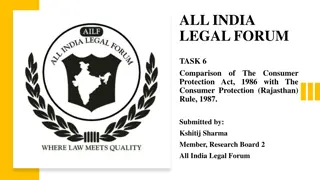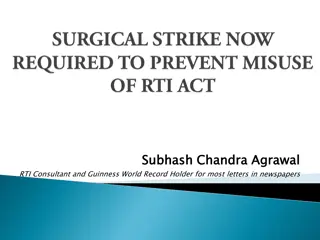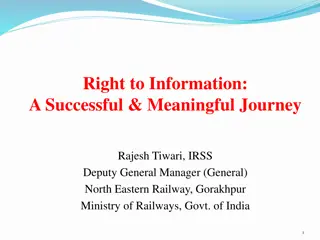Challenges in RTI Implementation: Rajasthan's Perspective
Rajasthan faces various challenges in the implementation of the Right to Information Act, 2005. Issues include gaps in suo-moto disclosure, faulty records management, and resource crunch manifestations. These challenges hinder the effective functioning of the RTI machinery in the state, impacting transparency and public access to information.
Download Presentation

Please find below an Image/Link to download the presentation.
The content on the website is provided AS IS for your information and personal use only. It may not be sold, licensed, or shared on other websites without obtaining consent from the author.If you encounter any issues during the download, it is possible that the publisher has removed the file from their server.
You are allowed to download the files provided on this website for personal or commercial use, subject to the condition that they are used lawfully. All files are the property of their respective owners.
The content on the website is provided AS IS for your information and personal use only. It may not be sold, licensed, or shared on other websites without obtaining consent from the author.
E N D
Presentation Transcript
Issues in RTI Implementation - the Rajasthan Experience 12thAnnual Convention on RTI New Delhi December 6, 2017
Implementation of RTI in Rajasthan RTI Act 2005 made effective in Rajasthan w.e.f. October 12, 2005 Estimated current state of RTI work in Rajasthan (annual basis): 200,000 information applications (under Sec. 6-1 of the Act) 20,000 first appeals (under Sec. 19-1 of the Act) 10,000 second appeals (under Sec. 19-3 of the Act) Present strength of the State Information Commission: CIC and 2 Information Commissioners Total other staff - 70
Gaps in Suo-moto Disclosure Inadequate steps taken by various public authorities for Sec. 4-1(b) implementation during initial preparatory phase Suo moto disclosure still lacking in quality - information needs of public are not fully met Many public authorities remain lukewarm towards requirement of constant updation of websites Third party audit of Sec. 4-1(b) compliance in most Public Authorities has not been attempted
Faulty Records Management RTI Act 2005 envisages transparency - State records to be freely accessible to lay public This presupposes methodical keeping of available record to allow hassle-free and smooth reach to items of interest Actual experience has been far from idyllic: record is badly stored and at times physically damaged indexation is largely absent manual perusal of voluminous files is only way to get to needed papers old files are difficult to locate large number of information seekers meet with stock reply that record is missing and copy can not be provided govt. officials are loath to make extra efforts to search for old and misplaced files they instead attempt to shift responsibility and divert applicants to sister offices or provide inadequate replies this leads to a plethora of consequent information requests and appeals and complaints, thereby burdening the RTI machinery inordinately
Resource Crunch Manifestation Poor Infrastructure: Inadequate SPIO offices, staffing shortages, basic storage/retrieval and copying equipment unavailable at village locations, lack of computerisation and internet connectivity Poor manpower: SPIO staff lack training, some officials continue to have apathetic mindset, bureaucratic approach and tendency to shirk both work and responsibility Poor quality of information provided: recourse taken to loopholes and technicalities, requests side-tracked and stonewalled, frequent recourse to missing files excuse
Suggestions for Moving Forward Sustained public awareness campaigns through existing govt. machinery and inclusion of reputed NGOs to increase RTI use by weaker and under-privileged sections Infusion of information and communication technology to overcome difficulties in RTI implementation and management Digitisation of records, starting with exhaustive file listings and proper indexation, to help locate/retrieve information Training of public officials , including for behavioural/attitudinal change and in use of new computer-based systems and procedures
Smooth Flow in RTI Work at Apex Level Another issue highlighted through ongoing analysis of work in the Rajasthan State Information Commission can be described as: allocation of hearing opportunity to appellants/complainants is based on first come first served basis in general various segments of information seekers can be discerned present glut of appeals/complaints can be attributed to some segments usage of Commission time and resources by these segments is disproportionate to their numerical size/strength equitable availability of hearing opportunity to all segments is defeated by such activity on part of these segments
Analysis of Work in RSIC Meta-data of appeals dealt with in the time period from January 2010 to August 2016 was scrutinised to determine number of appeals preferred by individual appellants A list of appellants was prepared in rising order of number of appeals by each appellant The numerical values of cumulative appeals (in percentage terms) preferred by cumulative share of appellants (also in percentage terms) was plotted This yielded a typical Lorenz curve depicting the inequality in usage of Commission time and resources by different appellants distinguished by volume of appeals preferred
Cumulative Appeals V/S Appellants Plot RSIC: Jan 2010 to Aug 2016 44376 appeals - 13838 appellants
Segmentation of Appellant Population To distinguish appellants on basis of volume of appeals preferred, they were characterized as Regular, Persistent and Dedicated: Regular preferred from 1 to 5 appeals in the period Persistent preferred from 6 to 50 appeals in the period Dedicated preferred more than 51 appeals in the period The numerical size of each segment was measured as also the total numbers of appeals preferred by each segment Plots of the share (in percentage terms) of each segment in number of appellants as also number of appeals preferred highlights the inequality in usage of Commission time and resources by them
% Appellants by Category RSIC: Jan 2010 to Aug 2016 13838 appellants in all
Appeals Preferred % by Category RSIC: Jan 2010 to Aug 2016 44376 appeals in all
Appellant Category & Impact on Resources RSIC: Jan 2010 to Aug 2016 13838 appellants - 44376 appeals
Putting Appellant Segments in Context Typical description of different appellant segments: Regular Information Seeker usually comes forward in a single matter related to personal need for particular information, either in case of missing record or refused category of SPIO response and easily reconciles to the existing factual or legal circumstance Persistent Information Seeker usually files multiple appeals in one or related matters of grievance redressal and at times seeks to use RTI as a weapon to browbeat target public officials or settle personal grudges Dedicated Information Seeker usually files scores of appeals in numerous matters with view to social service, possible self-aggrandizement or even to dominate target SPIO offices for either influence-peddling or downright blackmail and extortion (the latter self-seekers may often outnumber the public spirited in ratio)
Dealing with Inherent Inequalities There is need to encourage the Regulars while discouraging the self- seeking component in the other segments in the interest of actualising the outcomes of transparency, accountability and efficiency that the RTI Act promises Public awareness campaigns, strengthening of public grievance redressal mechanisms, infrastructure build-up and proper training to improve human resources could go a long way towards this The glut of appeals coming from self-seekers could be addressed by prioritising the scheduling or listing of appeals from the Regulars over the others one way sometimes suggested for this being the limiting of daily hearings to at most two for any given appellant























